| Home > Intro
> Media >
Sony
Digital Cameras > Sony Cybershot DSC-P72 Sony Cyber-shot DSC-P72 Digital Camera
Suggested Retail Price: $349 Sony is one of the dominant players in the digital camera market. Their
cameras offer excellent features and performance, good quality
and great pictures. They currently offer five
distinct lines of cameras, spanning an incredible range of features,
price, and performance.
The DSC-P72 is equipped with a 3x, 6-18mm lens, equivalent to a
39-117mm lens on a 35mm camera. This is a fairly typical range,
slightly biased toward the telephoto end relative to the more common
35-105mm range found on many 3x zoom-equipped cameras. Normal focus
ranges from approximately 1.64 feet (0.5 meters) to infinity, with a
Macro (close-up) setting that lets you get within four inches (10 centimeters)
when the lens is zoomed to its wide angle position, and 19.75 inches
(50 centimeters) at its telephoto setting. (The net result is about
average performance in closeup shooting.) In addition to automatic
focus control, the DSC-P72 offers a total of five fixed focus
settings through the Record menu, as well as Center AF and Multi AF
focus area options. Exposure is automatically controlled at all times on the DSC-P72,
great for novices and casual users looking for simplicity. You can
override the exposure with an exposure compensation adjustment
though, a necessary feature for shooting subjects that are uniformly
light or dark overall. Although the camera controls aperture and shutter speed, it does
report the settings it has chosen on the LCD information display, so
you have an idea of what the exposure will be.
Knowing the actual shutter speed can be very helpful in judging
whether or not you'll be able to successfully hand hold an exposure
in dim lighting. The Record menu offers additional exposure options
of White Balance, Exposure Compensation, Spot Metering, ISO, Record
Mode, Flash Level, Picture Effects, Focus, and image quality
settings. Under the Picture Effects setting, you can record images
in black and white or sepia monochrome, or select the Solarize or
Negative Art options. In Movie exposure mode, the camera captures either 640 x 480-, or 160 x 112-pixel resolution moving images with sound for as long as the memory card has available storage space. Unrestricted (other than by card capacity) recording at 640 x 480 pixels is quite unusual in digicams, and is the key feature that distinguishes Sony's MPEGmovieVX mode. The DSC-P72 also offers Clip Motion and Multi Burst modes. Clip Motion records a series of up to 10 images that are automatically saved in a single animated GIF file, and that can be played back as an animation sequence. Multi Burst mode captures an extremely rapid 16-frame burst of low-resolution images, at a selectable rate of 7.5, 15, or 30 frames per second. Multi Burst shots are played back as a slow-motion animation on the camera, but appear as a single large file with 16 sub-images in it when viewed on a computer. A Self-Timer mode provides a 10-second delay between the time the Shutter button is pressed and the time that the camera actually takes the picture, giving the photographer time to run around and get into the picture. Also available on the DSC-P72 are Burst 2 and Voice record modes. Burst 2 records two images in rapid succession, with one press of the Shutter button. Voice mode records a short sound clip to accompany an image, useful for attaching voice captions. The DSC-P72 stores images on Sony Memory Sticks, available
separately in capacities as large as one gigabyte. (The DSC-P72 is
compatible with Sony's new Memory Stick PRO format, breaking the
previous 128 MB barrier for Memory Stick storage.) A 16MB Memory
Stick comes with the camera. As with last
year's mid-sized P-series models, the P72 once again departs from
Sony's typical practice of using their proprietary "InfoLITHIUM"
batteries, using instead two AA batteries for power, either
alkaline, NiMH, or lithium. A set of two rechargeable NiMH AAs and a
battery charger are included in the box with each camera. Battery
life is quite good for a two-AA cell camera, but still, pick up a couple of extra sets of rechargeable AA
batteries and pack them along on any extended outing. Basic Features
Special Features
Like the rest of the mid-sized "P" series of Sony Cyber-shot
cameras, the DSC-P72 is a good quality, compact digicam. It offers
the convenience of point-and-shoot simplicity, but with enough
advanced features to make it possible to take photos in otherwise
challenging situations (low light, fast action, etc.). The
3.2-megapixel CCD delivers high quality images, appropriate for any
use from printing to distributing via e-mail, and its compact design
makes it a good candidate for travel. (While not as tiny as cameras
like Sony's own P8 and P9, or the Canon Digital ELPH series, the P72
fits quite nicely into pant or coat pockets.) Overall, the P72 is a
good choice for anyone wanting a capable, portable camera that takes
good photos in a variety of circumstances. The DSC-P72 is easy to
use for beginners, but has enough flexibility to handle a range
of conditions. Design FRONT VIEW
The front of the DSC-P72 is rounded on the right side, following the shape of the lens barrel and adding to the smooth design aesthetic. A shutter-like, retractable lens cover protects the lens whenever the camera is powered off, flipping quickly out of the way when the camera is turned on again. The lens telescopes out from the camera body about 3/4-inch into its operating position. Also on the front panel are the flash, optical viewfinder window, AF illuminator lamp, and small microphone. A small, sculpted ridge serves as a finger rest when holding the camera, improving your grip to a surprising degree. Still, this ridge is small enough that you'll probably want to keep the wrist strap securely in place while shooting. Battery Compartment On the right side of the camera (as viewed from the back) is the battery compartment. A sliding plastic door protects the compartment, and features a latch that prevents it from accidentally flying open while shooting. Just below the compartment is the wrist strap attachment eyelet. Memory Stick Slot The opposite side of the camera features only the Memory Stick compartment, at the very bottom. A hinged, plastic door opens downward to reveal the card slot. TOP VIEW
The DSC-P72's top panel is fairly smooth and flat, featuring only the Shutter and Power buttons, both of which barely protrude from the camera's surface. BACK VIEW
The few remaining camera controls are on the back panel, along with the optical viewfinder eyepiece, LCD monitor, speaker, and connector jacks. Three LED lamps next to the optical viewfinder report camera status, indicating when focus is set or the flash is charging. The Mode dial and Zoom rocker button dominate the top left corner of the back panel, while the Menu, Display, Image Size / Erase, and Four Way Arrow pad line up below them. A small speaker is on the left side of the LCD monitor. On the right side, beneath the Zoom rocker button, a tethered plastic flap covers the DC In, Video Out, and USB connector jacks. Two ridges on the outside of the plastic flap serve as a thumb grip while holding the camera. BOTTOM VIEW
The DSC-P72 has a flat bottom panel, which holds the metal tripod socket and bottom side of the Memory Stick slot.
Record-Mode Display
In Playback mode, this button controls the digital enlargement of captured images and accesses the index display mode as well as a detailed information display. (The "T" side zooms in, the "W" side zooms out. Zooming out from the normal-sized single image view brings up an index display of tiny "thumbnail" images.)
In Playback mode, this button pulls up the single erase menu, letting you delete the currently displayed image.
In Automatic Record mode, the up arrow controls flash mode, cycling through Auto, Forced, and Suppressed modes (it only activates Slow-Sync in Twilight Portrait mode, and no flash modes are available in Twilight, Landscape, or Movie modes). The down arrow activates the Self-Timer option, while the right arrow controls the Macro mode (close-up). The left arrow calls up a quick review of the most recently-captured image. In Playback mode, the left and right keys scroll through captured images on the memory card. When an image has been enlarged, all four arrow keys move around within the enlarged view.
|
|
Camera Modes and Menus Record Mode: In this mode, the camera captures standard still images, controlling aperture and shutter speed. Pressing the Menu button displays the Record settings menu, with options varying depending on the exposure mode selected:
Set-Up Mode: The following three page Set-Up menu automatically displays when entering this mode:
Recommended Software:
Specifications
|
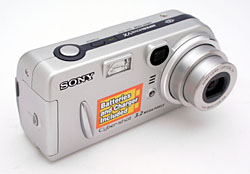
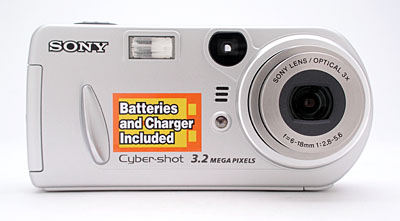
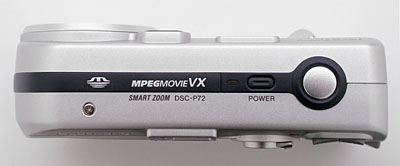
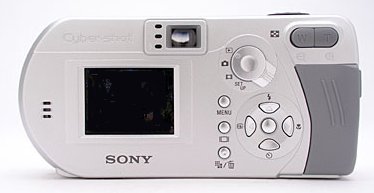
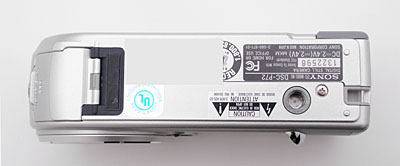
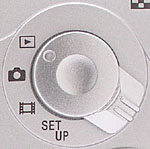

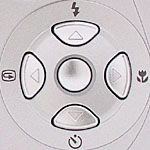
 Camera:
Camera:
 Memory Stick Tool
Memory Stick Tool
 Setup 1
Setup 1
 Setup 2
Setup 2